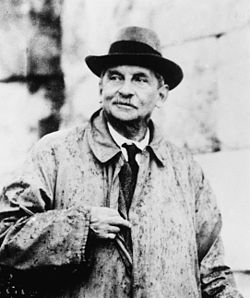
Back آرثر إيفانز Arabic آرثر ايفانز (باحث انثروبولوجيا) ARZ Artur Evans Azerbaijani آرتور ایوانز AZB Артур Джон Эванс Byelorussian Артур Джон Эванз BE-X-OLD Артър Еванс Bulgarian Arthur Evans Catalan Arthur Evans Czech Arthur Evans Welsh
Sir Arthur Evans | |
|---|---|
 | |
| Born | Arthur John Evans 8 July 1851 Nash Mills, Hertfordshire, England |
| Died | 11 July 1941 (aged 90) |
| Alma mater | Brasenose College, University of Oxford |
| Known for | Excavations at Knossos; developing the concept of Minoan civilisation |
| Awards | Fellow of the Royal Society[1] |
| Scientific career | |
| Fields | Archaeology, museum management, journalism, statesmanship, philanthropy |
| Institutions | Ashmolean Museum |
Sir Arthur John Evans FRS FBA FREng[1][2] (8 July 1851 – 11 July 1941) was a British archaeologist and pioneer in the study of Aegean civilization in the Bronze Age.
The first excavations at the Minoan palace of Knossos on the Greek island of Crete began in 1877. They were led by Cretan Greek Minos Kalokairinos, a native of Heraklion. Three weeks later Turkish authorities forced him to stop (at the time, Crete was under Ottoman occupation). Almost three decades later, Evans heard of Kalokairinos' discovery. With private funding, he bought the surrounding rural area including the palace land. Sir Arthur Evan began his own excavations in 1900.
Based on the structures and artefacts found there and throughout the eastern Mediterranean, Evans found that he needed to distinguish the Minoan civilisation from Mycenaean Greece.[3] Evans was also the first to define the Cretan scripts Linear A and Linear B, as well as an earlier pictographic writing.
- ^ a b Myres, J. L. (1941). "Arthur John Evans. 1851–1941". Obituary Notices of Fellows of the Royal Society. 3 (10): 940–968. doi:10.1098/rsbm.1941.0044. S2CID 162188868.
- ^ "List of Fellows". Archived from the original on 8 June 2016. Retrieved 16 October 2014.
- ^ Evans 1921, p. 1